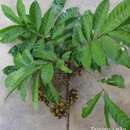Comprehensive Description
provided by Smithsonian Contributions to Botany
Guarea cedreta (A. Chevalier) Pellegrini
Standard trade name: Scented Guarea
Local names: Kwabohoro (Ghana), Bosse (France & Ivory Coast), Obobonufua (Nigeria)
A heavily buttressed tree up to 160 ft tall and up to 8.5 ft in girth; bole clear, considerably fluted at the base; crown dense; bark silvery gray; leaves pinnate with 4 to 6 pairs of leaflets; flowers green, with few-flowered inflorescences.
GENERAL DESCRIPTION.—Guarea is medium hard and of medium weight, about 36 lb/ft3 seasoned and about 60 lb/ft3 green. The pinkish brown heartwood is like pale African mahogany. The sap-wood is lighter in color than the heartwood. Freshly sawn, guarea has a strong cedar-like scent, which tends to disappear on exposure. The timber has a medium-fine texture and a high luster. The grain may be straight or wavy, and a mottled or curly figure may be present.
SEASONING.—The timber appears to season fairly rapidly with very little degrade. Resin exudation may cause some degrade in the appearance of the wood. The British Forest Products Laboratory kiln schedule E has given satisfactory results (FPRL, 1956).
DURABILITY.—Moderately durable, but damage by ambrosia beetles is sometimes present. It is extremely resistant to preservative treatment. The sapwood is permeable.
WORKING QUALITIES.—Generally it saws and planes fairly easily. It works satisfactorily with hand and machine tools, but dulls their cutting edges. There is a slight tendency to pick-up in planing quarter-sawn material, but generally a good finish is obtained in most operations. It takes nails and screws well and stains readily. Polishing, however, needs care because of possible resin exudation.
USES.—Guarea is a superior joinery timber and is used for furniture, interior fittings, boats and vehicles, as well as for good quality plywood and decorative veneer.
XYLEM ANATOMY.—Growth rings present. Wood diffuse-porous. Vessels: solitary to groupings of 3, rarely more; average pore diameter 122μm; circular to narrowly elliptical in outline; average vessel length 536μm, range 300μm–788μm; vessel wall thickness 5μm; perforation plates, unable to determine with certainty but they appear simple. Vessel end wall inclination transverse to oblique; intervascular pitting alternate, simple, small and numerous. Imperforate tracheary elements: septate fiber tracheids; average length 1668μm, range 1325μm–2000μm. Vascular rays: homogeneous, generally one celi in thickness, but frequently with 2 or 3 small cells abreast. Axial parenchyma: apotracheal, banded, moderately abundant pitted. Crystals and inclusions: no crystals apparent; however, some ray cells contain dark staining deposits.
- bibliographic citation
- Ayensu, Edward S. and Bentum, Albert. 1974. "Commercial Timbers of West Africa." Smithsonian Contributions to Botany. 1-69. https://doi.org/10.5479/si.0081024X.14

